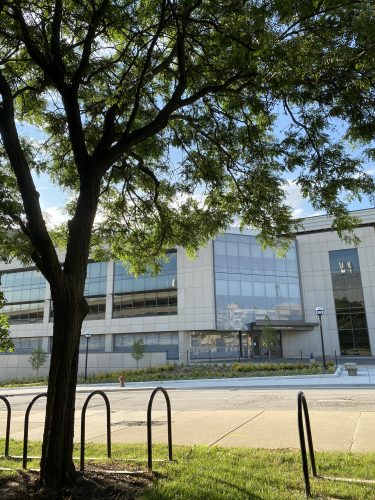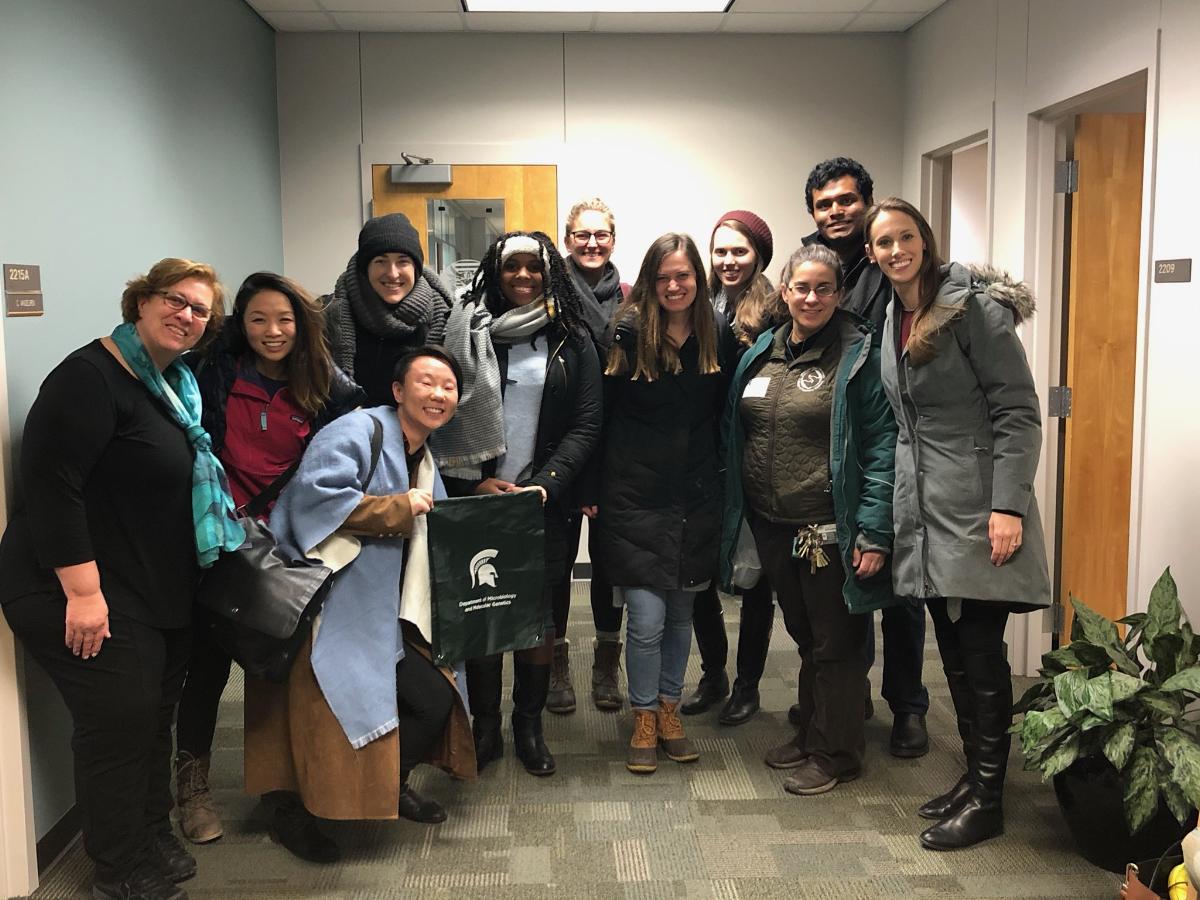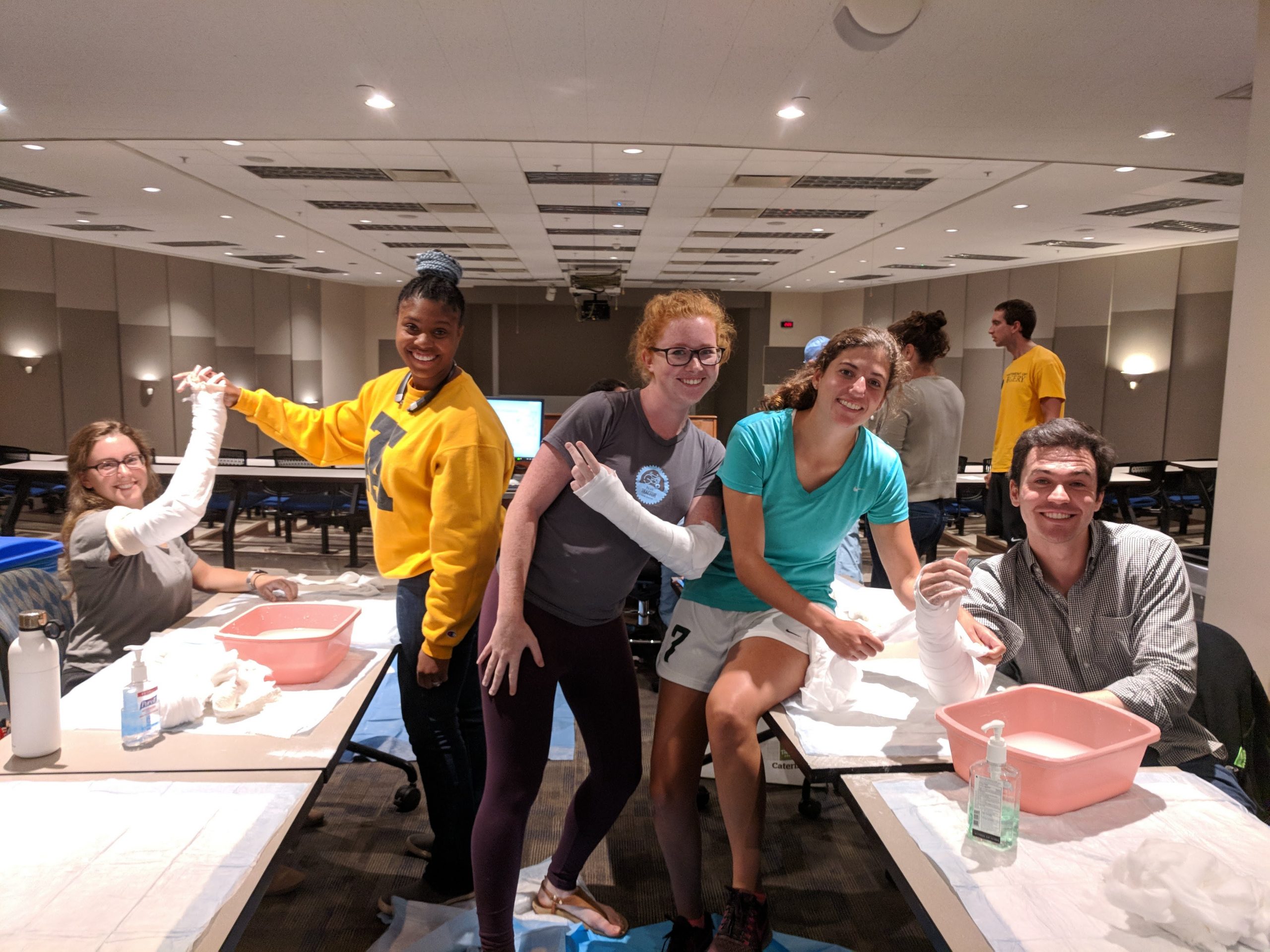by Lucy Zhuo | Jul 1, 2021

The trunks on most trees can look fairly similar. But the leaves on the branches can look quite different (like our curriculum)! Photo taken outside Taubman Health Sciences Library.
“Just wait until you get to the Branches!” I had heard some variation of this statement throughout my first two years of medical school whenever conversations about curricular flexibility came up. After finishing clerkship year and USMLE Step 1, my class entered into the “Branches” of the curriculum. As a brief primer, the University of Michigan Medical School divides the curriculum into two parts, the “Trunk” and the “Branches”. The Trunk is broken up into the pre-clinical and clinical trunks, which encompass the first two years of medical school at the University of Michigan. The Branches, the third and fourth years of medical school, is the 17-18-month period leading up to graduation that offers the freedom to explore future career choices and develop personal interests.
Admittedly, when I first heard about the Branches when I was as a pre-clinical “Trunk” student, the concept felt elusive, as our house counselors had told us that our experience would be what we chose to make of it. At baseline, we choose one of four possible Branch pathways, each offering a specific focus into patient care (Patients and Populations, Procedure-Based Care, Diagnostics and Therapeutics, or Systems and Hospital-Based Care) and establish relationships with advisors, both in our Branch and in our future specialty of choice (faculty career advisors). As part of our graduation requirements, we also must complete several rotations during the Branches, including at least four graded clinical electives, an ICU rotation, a sub-internship, and an EM rotation with protected time for residency interviews, a residency prep course, and vacation.
What I hadn’t realized as an M1 student was that as Branches students we would have a broad spectrum and diversity of opportunities at our fingertips, as long as we wanted to pursue them. We are encouraged to explore fields and interests that we may have a low likelihood of experiencing through residency that can help deepen previous interests or layer other interests to diversify and offer breadth to our personal studies. There are clinical electives from across 20+ departments — see a taste of what’s available below. Other more niche elective options include Wilderness Medicine, Comparative Medicine, Street Medicine, Disability Health, Visual Arts in Medicine, Medical Communication through Wikipedia, and more.
- Consult Service (Adult or Pediatric, 20+ services including cardiology, infectious diseases, and allergy)
- Anesthesia electives (Adult or Pediatric)
- Clinical Ethics Service
- Family Medicine in Japan
- Sleep Medicine
- Reproductive Endocrinology and Infertility
- Forensic Psychiatry
- Addiction Treatment Services
- Nuclear Medicine
- Interventional Radiology
- And…
The Branches offer significant time before working on residency applications to define and solidify future planning as well. For those who remain uncertain about their eventual field of choice, the Branches offer two week “exploratory” electives for students to learn more about fields that they hadn’t had previous exposure to, such as radiation oncology, dermatology, physical medicine and rehabilitation, anesthesiology, and sub-specialty surgical fields (orthopedics, ophthalmology, plastics, otolaryngology, neurosurgery, etc.). These electives are different from sub-internships (sub-Is), which are clinical rotations where the medical student is given the responsibilities and expectations to perform at the level of a first-year resident. A sub-I can be done on a variety of different services in a multitude of specialties.
There are many opportunities for creativity in the Branches as well. If a particular elective doesn’t exist, you can create your own individually arranged clinical elective (or INDARR as we affectionately call it). I have had peers create self-driven courses with topics such as cardiac electrophysiology, the intersection of transplant medicine and surgery, and narrative medicine (complete with a book reading list!). We can dedicate time and resources to work on research and our Capstone for Impact projects, our passion project intended to create a positive impact within health care. If there is a faculty physician we want to clinically learn from, we can arrange a longitudinal apprenticeship in which the student will go to the attending’s clinic on a weekly basis. During the months leading up to ERAS submission, some students will schedule clinical rotations at a different institution (“away rotations”) with the aim of experiencing a different institutional culture or eventually ending up there for residency.
As one example of the thousands of available permutations, my Branches schedule (listed below) has been focused on developing the perspective and skills to be a good general surgeon as well as revisiting my previous experience in health care finance and administration. However, this course I’ve charted for myself looks starkly different from my friend’s path (listed below mine), who is deciding between internal medicine and emergency medicine, with the final goal of critical care. If it’s not already obvious, some of the difficulty of broadly advising for the Branches is that your path forward is truly based on your own personal interests and future aspirations.

“Flight Paths” by Steve Waldeck, a 450-foot multisensory walk through a simulated Georgia forest, with a sculptural tree canopy that filters layers of light, surrounded by sounds and animation of local wildlife. Photo taken at Atlanta International Airport on my way home from Academic Surgical Congress (February, 2020).
My Branches path:
- Strategic Management for Physicians
- Anesthesia Clinical Elective
- Sub-I in Endocrine and Minimally Invasive Surgeries
- Surgical ICU Rotation
- Palliative Care Elective
- “Problem-Based Scientific Inquiry” (PBSI) Course
- Online Opioids Elective
- Research Elective
My friend’s Branches path:
- Anesthesia Clinical Elective
- Online Pediatric Injury Prevention Course
- Orthopedic Surgery Consult
- Medicine ICU rotation at St. Joe’s
- Emergency Medicine (EM) Rotation
- Sub-I in the IM Hospitalist Service
- EM away rotation at Henry Ford
- Apprenticeship with a pulmonary critical care physician
As my class enters the residency application season, the Branches have offered a wonderful period to prepare and propel us towards defining the careers we envision. We have the ability to draft the narrative we want as long as we’re willing to imagine it.
You can find more information about the Branches here.
by Erika Steensma | Apr 23, 2020
It looked like any of the number of procedural rooms that I had been in during the past four years of medical school. Behind a glass partition, there were rows of medications ranging from blood pressure drugs to birth control pills, many of which I had seen prescribed to my own patients. There was an x-ray machine in the corner, and a CT machine waiting next door. Various pieces of ventilating equipment were neatly stacked in metal bins and shelves lining the walls. It looked so familiar, that I could almost forget the reality: I was at the Detroit Zoo, and all of these medications and equipment were used to treat the exotic animals that reside there.
It was for this very reason–to understand the connections between human and animal health–that my classmate Kate Heckman and I developed a Comparative Medicine elective for upperclass medical students to take during their time in the Branches. The idea for comparative medicine, defined as the study of similarities and differences between animal and human medicine, is not new. It has been endorsed by famous physicians ranging from the historic Hippocrates to the more recent Dr. Virchow (who is known as “the father of modern pathology”). In fact, even the Center for Disease Control promotes the One Health Initiative, which aims to increase collaboration between physicians, veterinarians, and other health professionals.
Although there was a strong academic precedent for creating the course, I had a slightly different motivation in developing this elective. Growing up, I always had a wide range of academic interests. However, once in medical school, I was quickly overwhelmed by the sheer volume of information available for a medical student to study. Worried that I would be an incompetent physician if I did not commit to learning as much of it as possible, I focused all of my energy and time on studying human physiology, anatomy, and medicine; gradually, all of my other academic interests and passions fell to the wayside. I was worried that I was coming out of medical school less curious and less creative than I was when I started. The idea of developing a course in a field that interested me, but had little exposure to in medical school, seemed like the perfect opportunity to return to my roots and rekindle my passion for learning.
Although Kate and I had no prior experience with course development, we were mentored by Drs. Fox and Alsup, faculty within the medical school anatomy program, who helped us with the paperwork and administrative process of gaining course approval. Dr. Nemzek, a faculty member at the University of Michigan’s Unit for Laboratory Animal Medicine (ULAM) assisted us with curriculum development and connected us with various field experts for course lectures. Furthermore, with grant funding from the Medical School, we were able to cover the costs of educational sessions arranged at the Detroit Zoo and Michigan State University Veterinary School as well as fund a pet CPR certification course for students enrolled in the course. All of this exemplifies our Medical School’s approach to student-led projects; not only does Michigan encourage students to pursue their interests, but it provides the support and resources necessary to help them succeed.
In planning the lecture portion of our course’s curriculum, we found numerous physicians who, on top of their expertise in human medicine, had strong background knowledge in animal medicine and physiology. Our lectures included a discussion of how brain structure varies between species, and how this correlates to animal behavior led by Dr. Selwa, a neurologist. Dr. Green, an otolaryngologist, spoke on animal pharynx structure compared to human anatomy, explaining why humans can talk while other animals can’t. An emergency medicine physician held a Jeopardy-style trivia competition to teach about management of animal bites and stings. I was especially impressed that many of these lecturers studied comparative physiology and medicine on their own time, purely for their own interest. I was reassured to realize that being a good physician does not necessitate purely focusing one’s attention on human medical journals and literature.
However, my favorite parts of the course were the experiential learning trips that we arranged within the University of Michigan as well as community organizations and other academic centers. At Michigan, we visited the Unit for Laboratory Animal Medicine, where we learned about the ethics of animal research, the contributions that animal-based research has made to our understanding of human disease and medical care as well as the strengths and weaknesses of our current animal models of disease. I was pleasantly surprised to learn about the extent of research and effort that veterinarian staff at ULAM employ to give their animals a good quality of life, including strategies to provide social and intellectual enrichment.

We loved having the opportunity to learn from the veterinary experts at Michigan State University!
We also arranged a trip to the highly renowned Michigan State University School of Veterinary Medicine. We were given a tour of the facilities and learned about innovations in animal medicine that could potentially lead to development of new treatments for human diseases in fields such as oncology and ophthalmology. At the anatomy lab, we were tested with labeling the joints of a full-scale horse model. As we struggled through the exercise, asking questions such as “Do horses have elbows… or are they just called ‘front knees?”, I was struck both by how limited my knowledge base in comparative anatomy was, and yet how many correlations there are between the bones and anatomical structures of a horse and those of a human (I also learned that the “front knee joint” is actually called the carpus). Most of all, I was impressed by the enthusiasm of the staff and faculty at the Veterinary School in teaching medical students. They shared their delight in the course and expressed the value that they felt could be gained by further collaboration between our two fields, and by this point in the course, I could not help but agree.
Our course ended with an afternoon spent with Dr. Duncan, the director of veterinary medicine at the Detroit Zoo. She gave a brief talk on the Zoo’s program for maintaining heart health in the great apes, during which I was surprised to discover that the heart disease processes that gorillas face are similar to those I had seen in many of my patients at the hospital, as were the treatments–although I have never had to sneak medications to my patients through juice boxes, as the veterinary staff do. We were then given a tour of the procedural facilities, where animals are given physical exams and are treated for various ailments. Once again, my classmates and I were amazed at the degree of overlap in the equipment and medications used at our hospital and here at the zoo. We also learned that, for animals with complex or highly specific disease processes, zoo veterinarians often consult their human medicine counterparts with expertise in the disease to help with management and treatment of the animals. It was a career opportunity that few of us realized existed, and many of us resolved to take part in someday.
During the yearlong process of developing the comparative medicine course, the question that I most frequently received from classmates, family, and friends was “why?” Why should medical students spend their time learning about animals, when there are so many human medicine topics to study? At the time, I would fumble for a response, mumbling something about “gaining a background for research” and “expanding our knowledge base.” But now, I would argue, why not? I came to medical school worried that if I didn’t focus all of my attention on human medicine, I would become a worse physician in the future. As I look forward to graduating in one month, I realize that the effect is actually the opposite. By taking time during my third and fourth years of medical school to explore my interests in narrative writing and comparative medicine, I have not only become a more well-rounded student, but I have found myself asking more questions, reading more books, and most importantly, enjoying learning and studying once again. Exploring passions that lie outside of strictly human medicine can allow for medical students and physicians to retain the curiosity and passion that allowed them to succeed academically, and will continue to serve them in their care of patients.
by Kate Heckman | Jan 16, 2020
Mount Ojibway, Isle Royale National Park: elevation 1,152 feet
Thus read the signpost I’d hiked so far to reach. My friends and I gathered together to gaze across the untouched landscape of primitive Isle Royale down to the spectacularly beautiful Lake Superior far below.
Sound like a dream? Absolutely!
Think I’m describing a vacation? Think again!
In my wildest hopes, fears, and dreams for medical school, never did I imagine that my education might involve a seven-day remote backpacking trip. You would appreciate the improbability of this, too, if you could only see how I scream and run from the spiders in my house, or witness my unhealthy dependence upon the microwave oven. Nonetheless, here I was, in the midst of some serious applied learning for my Wilderness Medicine elective course. Following this impossibly scenic – but brief – Mount Ojibway lunch break, the day’s agenda still included four more miles of hiking, a lecture about avalanches from my classmate Bri, some regrettably opportune blister care training courtesy of Emergency Medicine resident and trip leader Erika, and a group dinner around an eagerly anticipated campfire.

Bella, Joel, Brooke, Megan, Cameron, and Courtney represent University of Michigan even on our remote weeklong backpacking trip on Isle Royale. Go Blue!
How did I come upon this Wilderness Medicine educational opportunity, you ask? The answer lies in the Branches. Anyone who is ever-so-slightly familiar with the University of Michigan Medical School has likely heard all about our new curriculum, which features a unique 17-month “Branches” phase. The “Branches” refers to elective educational time following the standardized core didactic and clinical curriculum, which allows students to customize their medical education. This affords ample time for research, volunteerism, international experiences, career exploration, educational enrichment, or whatever pursuits fit your educational mission.
I’m someone who likes to know a little something about everything, so I capitalized on my Branches time to experience (seemingly) every medical subspecialty known to mankind. You name it, I did the elective: Critical Care, Ophthalmology, Anesthesiology, Emergency Medicine, Gastroenterology and Hepatology, Plastic Surgery, Otolaryngology, Radiology, Dermatology, and more. (I even created my own elective in Comparative Medicine along with my classmate Erika!) It is almost unheard of for a physician to have formal, dedicated exposure to such a variety of fields, but this diversity of experience will prove invaluable in my future Internal Medicine practice: starting as a resident this July, I will serve as the first point of contact in the medical system for patients with any and all medical problems.
The Wilderness Medicine course was just as invaluable an experience as these electives, and arguably the most fun. This class offered a medical approach to all things austere courtesy of University of Michigan’s Emergency Medicine doctors Nate, Will, Bella, and Erika. Notable lectures covered animal attacks, lightning injuries, submersion injuries, altitude illness, and avalanches. Outside of the classroom, our hands-on experiences were truly wild. We learned about caving rescue operations from the experts at Buckner Cave in Indiana, then tried our hand at rescuing a volunteer “victim” – our poor, brave classmate Laura – from a section of the cave that was only 12 inches tall! (I’m still not sure how we pulled that off.) We practiced recognizing toxic plants and learned to distinguish them from edible look-alikes at the Michigan State University Botanical Gardens – yes, taste-testing was involved for those of us confident in our knowledge! We put our water purification skills to the ultimate test while camping, under risk of acquiring a friendly moose tapeworm. Needless to say, this knowledge base in common wilderness practices and emergencies will serve me well when any “outdoors-y” medical questions arise from patients, friends, or family.

Bri, LaVana, Laura, Megan, and Cameron show off their casting work following an emergency splinting lecture from the Orthopedic Surgery residents for the Wilderness Medicine class.
Upon reflection, though, I’ve realized that Wilderness Medicine – for all its crazy adventures – was not so different from the rest of my medical school experience. After all, I’ve spent the last four years conquering the unknown and doing things I never would have imagined!
For example, I still remember my terror at the prospect of seeing my very first patient. I was on the inpatient Obstetrics service, and my patient had given birth via cesarean section (“c-section”) the day prior. I stalled pretty impressively by reading her chart, taking the stairs, and sipping my coffee, thinking “I can’t do this.” But when I pictured this scared woman lying in a hospital bed hoping to see a doctor – and let’s be honest, when my coffee ran empty and I was almost out of time before the team’s morning meeting – the words “I can’t” turned to “I must.” I’m sure I was anything but adept and confident, but hey, every medical provider starts by seeing their first patient ever. Since then, seeing patients has become second nature through practice, practice, practice.
My subsequent clinical experiences would only bring more stretching and unexpected undertakings: delivering babies, procuring organs for life-saving transplant operations, suturing wounds, responding to emergencies, and performing CPR, to name a few. Not to mention amassing an amount of knowledge I never would have believed possible for such a short (yes, short!) period of study as medical school.
Even now, as a fourth-year student who has finished applying for residency, I’m taking on new things. In dermatology clinic today, I performed my first punch biopsy of a difficult-to-diagnose skin condition. With close guidance from my supervising dermatology resident physician – shout-out to Dr. Hawkins – the procedure was a success! We hope that our Pathology colleagues, who will evaluate the biopsy, can help us confirm a diagnosis for this patient soon.
All in all, Wilderness Medicine was the highlight of what has been a challenging but rewarding four years of medical school. This course underscored the most important thing I’ve learned from medicine – I am capable of more than I imagine. I’m excited for the next phase of my adventure as my classmates and I begin residency this summer. Bring on the challenge – it’s what we do!





